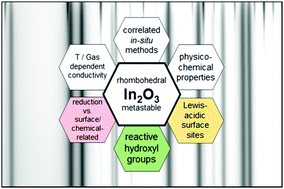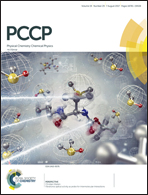Surface chemistry and stability of metastable corundum-type In2O3†
Abstract
To account for the explanation of an eventual sensing and catalytic behavior of rhombohedral In2O3 (rh-In2O3) and the dependence of the metastability of the latter on gas atmospheres, in situ electrochemical impedance spectroscopic (EIS), Fourier-transform infrared spectroscopic (FT-IR), in situ X-ray diffraction and in situ thermogravimetric analyses in inert (helium) and reactive gases (hydrogen, carbon monoxide and carbon dioxide) have been conducted to link the gas-dependent electrical conductivity features and the surface chemical properties to its metastability towards cubic In2O3. In particular, for highly reducible oxides such as In2O3, for which not only the formation of oxygen vacancies, but deep reduction to the metallic state (i.e. metallic indium) also has to be taken into account, this approach is imperative. Temperature-dependent impedance features are strongly dependent on the respective gas composition and are assigned to distinct changes in either surface adsorbates or free charge carrier absorbance, allowing for differentiating and distinguishing between bulk reduction-related features from those directly arising from surface chemical alterations. For the measurements in an inert gas atmosphere, this analysis specifically also included monitoring the fate of differently bonded, and hence, differently reactive, hydroxyl groups. Reduction of rh-In2O3 proceeds to a large extent indirectly via rh-In2O3 → c-In2O3 → In metal. As deduced from the CO and CO2 adsorption experiments, rhombohedral In2O3 exhibits predominantly Lewis acidic surface sites. The basic character is less pronounced, directly explaining the previously observed high (inverse) water–gas shift activity and the low CO2 selectivity in methanol steam reforming.



 Please wait while we load your content...
Please wait while we load your content...